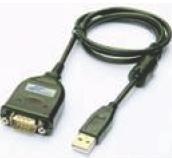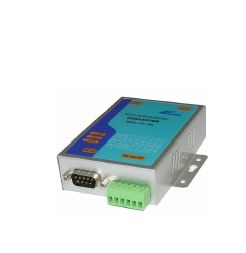
TCP/IP To 4-Port RS232/RS422/RS485 Converter
Price 22000 INR/ Piece
TCP/IP To 4-Port RS232/RS422/RS485 Converter Specification
- Range
- Ethernet: 10/100Mbps, Serial: Up to 115.2Kbps
- Battery Backup
- No
- Mounting Type
- DIN Rail / Wall Mount
- Power Supply
- DC 9~36V, 2A
- Connectivity Type
- Wired Ethernet, RS232/RS422/RS485
- Size
- Compact
- Frequency
- 50/60Hz
- Application
- Industrial Automation, Remote Data Acquisition, Serial Device Networking
- Dimension (L*W*H)
- 175mm x 125mm x 30mm
- Material
- Metal Enclosure
- Weight
- 800g
- Capacity
- 4 Serial Ports
- Coverage Area
- Up to 100 meters (serial line); Ethernet depends on network
TCP/IP To 4-Port RS232/RS422/RS485 Converter Trade Information
- Minimum Order Quantity
- 1 , , Piece
- Supply Ability
- 100 Pieces Per Week
- Delivery Time
- 7 Days
About TCP/IP To 4-Port RS232/RS422/RS485 Converter
ATC 2004 TCP/IP to 4-Port RS232/RS422/RS485 Converter
Technical Specifications:
| Computer Interface | : 3 in 1 (4-Port) RS -232/RS-422/RS-485 Interface |
| Transmission rate | : 230KBPS serial interface and 10/100 MBPS Ethernet |
| Signal Indication | : LINK (Indicate Ethernet link), ACT (Sending / Receiving data serial to Ethernet), PWR (Power Indication) |
| Supply | : 924VDC |
| Working Environment | : 0C70C, 10%95%RH |
Features:
- RS-232/422/485 4-in-1 serial Port interface 300-230.4KBPS Interface.
- RS-485 conversion offers automatic data control, support 2,4 wire RS-485.
- All serial ports have built in 600W lightning protection.
- 10/100M Ethernet, auto detect straight/cross cable.
- Support protocols like TCP/IP,UDP,DHCP,PPPoE, Dynamic DNS.
- Support standard DIN-rail, easy to instal land fix, compact size (95x65x25mm).
Versatile Serial Communication
This converter allows each of its four ports to be individually set to RS232, RS422, or RS485 modes, catering to varied industrial protocols and requirements. Supporting multiple baud rates and flow control mechanisms, it ensures compatibility with a wide array of legacy and modern serial equipment.
Easy Network Integration
Equipped with 10/100Mbps Ethernet connectivity, the device enables secure and efficient networking of serial devices over TCP/IP. Users can manage settings and monitor status via web browser, console, SNMP, or Telnet, streamlining remote management and troubleshooting.
Industrial Durability and Flexibility
Housed in a robust metal enclosure with DIN rail and wall mount options, the converter is engineered for demanding industrial environments. Its compact form factor and low power consumption (<5W) make it ideal for space-constrained installations.
FAQs of TCP/IP To 4-Port RS232/RS422/RS485 Converter:
Q: How can each serial port be configured for RS232, RS422, or RS485 communication?
A: Each of the four serial ports on the converter can be individually configured for RS232, RS422, or RS485 modes via the web browser or console management interface, ensuring precise adaptation to different hardware requirements.Q: What is the maximum baud rate supported by this device?
A: The converter supports baud rates ranging from 300bps up to 115.2Kbps, allowing integration with fast and legacy serial devices across various industrial applications.Q: When should I use the built-in flow control options such as RTS/CTS or XON/XOFF?
A: Flow control options like RTS/CTS and XON/XOFF are useful when connecting devices that require regulated data transmission, preventing buffer overflow and ensuring reliable serial communication in demanding environments.Q: Where is the optimal installation location for this converter in industrial settings?
A: The converter can be mounted on a DIN rail or directly on a wall, making it suitable for installation in control panels, machinery enclosures, or remote data acquisition setups within coverage areas up to 100 meters for serial lines.Q: What is the process for upgrading the firmware of the converter?
A: Firmware upgrades are supported through the web interface. Users can upload new firmware directly from their browser, ensuring the device stays up-to-date with feature enhancements and security updates.Q: How is remote device management achieved with this converter?
A: Remote management can be performed via web browser, console, SNMP, or Telnet. This flexibility enables network administrators to configure, monitor, and troubleshoot conveniently from any location within the network.Q: What benefits does this converter offer for industrial automation and data acquisition?
A: By bridging serial devices with Ethernet networks, the converter simplifies data integration, enhances scalability, and supports centralized monitoringcrucial for efficient industrial automation, remote monitoring, and real-time data acquisition.

Price:
- 50
- 100
- 200
- 250
- 500
- 1000+
More Products in Communication Product Category
Ethernet Embedded Module
Minimum Order Quantity : 1 , , Piece
Dimension (L*W*H) : 57mm x 35mm x 17mm
Weight : 25g
Product Type : Ethernet Embedded Module
Application : Industrial Automation, Data Acquisition, Network Communication
RS485 To USB Converter
Price 1850 INR / Piece
Minimum Order Quantity : 1 Piece
Dimension (L*W*H) : 67 x 30 x 24 mm Millimeter (mm)
Weight : 0.1 Kilograms (kg)
Product Type : USB to serial converter
Application : USB to serial converter
Optically USB Isolated Converter
Price 7100 INR / Piece
Minimum Order Quantity : 1 Piece
Dimension (L*W*H) : 105 mm X 85 mm X 27 mm Millimeter (mm)
Weight : 0.6 Kilograms (kg)
Product Type : RS232 / RS422 / RS485 (3 in 1) to USB Isolated Converter
Application : USB to serial converter
 |
MICON AUTOMATION SYSTEMS PVT. LTD.
All Rights Reserved.(Terms of Use) Developed and Managed by Infocom Network Private Limited. |

 English
English Spanish
Spanish French
French German
German Italian
Italian Chinese (Simplified)
Chinese (Simplified) Japanese
Japanese Korean
Korean Arabic
Arabic Portuguese
Portuguese Send Inquiry
Send Inquiry




